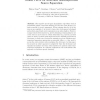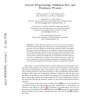282 search results - page 3 / 57 » Parsimonious dictionary learning |
291
Voted
ICA
2012
Springer
13 years 8 months ago
2012
Springer
Non-negative spectrogram factorization algorithms such as probabilistic latent component analysis (PLCA) have been shown to be quite powerful for source separation. When training d...
134
Voted
CORR
2006
Springer
15 years 21 days ago
2006
Springer
Fitness functions based on test cases are very common in Genetic Programming (GP). This process can be assimilated to a learning task, with the inference of models from a limited n...
110
click to vote
ICPR
2008
IEEE
15 years 7 months ago
2008
IEEE
Visual dictionaries are widely employed in object recognition to map unordered bags of local region descriptors into feature vectors for image classification. Most visual dictiona...
93
Voted
IBPRIA
2007
Springer
15 years 6 months ago
2007
Springer
Abstract. By applying recent results in optimization transfer, a new algorithm for kernel Fisher Discriminant Analysis is provided that makes use of a non-smooth penalty on the coe...
141
click to vote
ICML
2010
IEEE
15 years 1 months ago
2010
IEEE
We develop an efficient learning framework to construct signal dictionaries for sparse representation by selecting the dictionary columns from multiple candidate bases. By sparse,...


